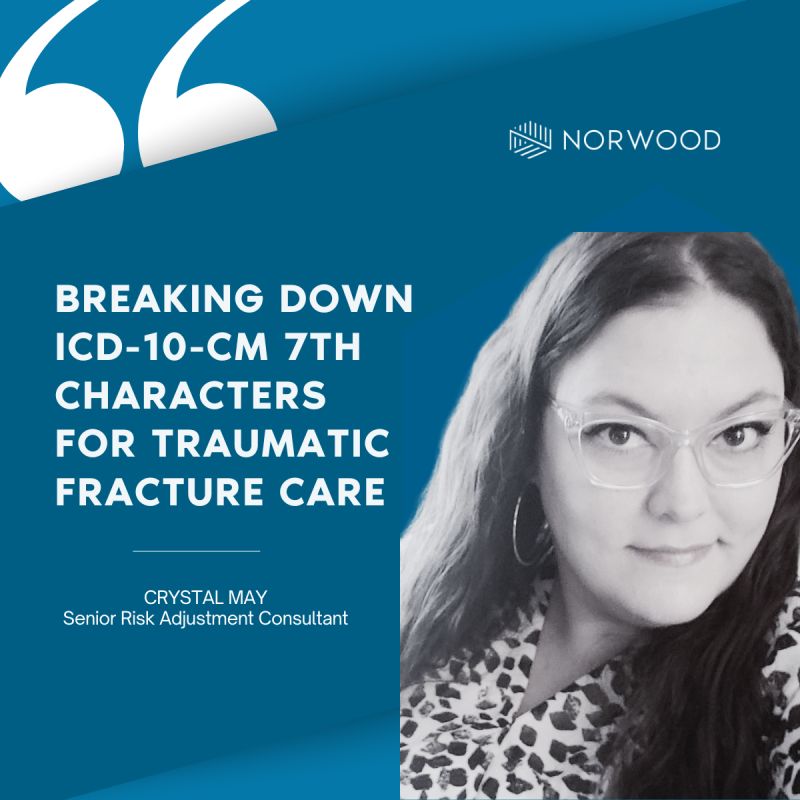
Crystal May, CCS, CPC, CDEO, CPMA, CRC, AAPC Approved Instructor
Sr. Risk Adjustment Consultant, Norwood
Coders often get overwhelmed with coding traumatic fractures, typically due to the numerous 7th characters available. But coding them isn’t as scary as it seems once you understand how they break down.
The first question you must ask is, is active treatment happening? Like other 7th characters applied throughout ICD-10-CM (A, D, and S), the 7th characters for fractures are broken down into initial, subsequent, and sequela codes. Those subsequent codes are where many coders get confused and overwhelmed, often due to the sheer number of options.
We’ll touch on those in a bit. But first, we must determine which type of fracture encounter we’re trying to code.
Initial, Subsequent, or Sequela?
When reviewing the documentation for fracture coding, look for active treatment occurring at the visit. For example:
- Is a cast being applied?
- Is manipulation taking place?
- Is there a change in the care plan?
If active treatment is occurring, use the 7th character A, B, or C – which one will depend on the fracture type being addressed and whether it’s an open or closed fracture. Remember that Official Coding Guideline 1.C.19.c tells us that if a fracture isn’t documented as open or closed, we will default to closed; if there is no specificity for displaced or non-displaced, we will default to displaced.
If there is no active treatment, we must determine if the patient is in the healing/recovery phase or if a sequela may be at play. For example, a patient has a permanent limp from a hip fracture 3 years ago – this would be considered a sequela and require using “S” for the 7th character. On the other hand, a patient following up two months after breaking their arm who has x-rays taken to confirm healing would be a subsequent visit since there is no active treatment occurring. In this case, the appropriate subsequent visit 7th character would be applied per the visit documentation.
If the patient is in the healing phase but NOT receiving active treatment, the subsequent codes come into play. This is where many coders get overwhelmed, so let’s take a closer look by breaking them down into groups:
- Routine Healing
- Closed
- Open, Type I/II
- Open, Type IIIA/B/C
- Delayed Healing
- Closed
- Open, Type I/II
- Open, Type IIIA/B/C
- NONunion
- Closed
- Open, Type I/II
- Open, Type IIIA/B/C
- MALunion
- Closed
- Open, Type I/II
- Open, Type IIIA/B/C
As you can see above, there is a predictable pattern when you group the options based on whether there is routine healing or complications of healing. Each “healing group” has options for a closed fracture, an open fracture of type I or II, and an open fracture of type IIIA, IIIB, or IIIC.
What’s the difference between the complications of healing? What constitutes delayed healing versus NONunion vs MALunion? Documentation.
- Delayed healing is defined as a fracture taking longer than usually expected.
- NONunion is defined as a fracture that has failed to mend after an extended time.
- MALunion is defined as a fracture that has healed in an abnormal position.
Provider documentation determines all aspects of the fracture puzzle and how the pieces fit together.
So, how does this get put together for a final code? Let’s see what pieces of information we need:
- What is the anatomic location of the fracture (for indexing)?
- Is there active treatment or would this be a subsequent visit or sequela?
- Is the fracture open or closed? Displaced or non-displaced?
- Is the type of fracture documented? (Type I, IIIA, etc.)
- Is there routine healing, or are there complications? If so, what kind?
Once you have the answers to these questions, combine the pieces to get the complete picture.
Coding traumatic fractures with 7th characters needn’t be scary or overwhelming, but if you struggle, review the accompanying decision tree and let it help you choose the appropriate 7th character the next time you’re coding a traumatic fracture.
Crystal May, CCS, CPC, CDEO, CPMA, CRC, AAPC Approved Instructor, is a Senior Risk Adjustment Consultant for Norwood, a company dedicated to providing unmatched staffing and solutions to support the mid-revenue cycle of healthcare organizations nationwide. Learn more at www.norwood.com.
Related News & Insights
Code Red: CMS announces massive audit expansion of Medicare Advantage, raising risk adjustment coding questions
By Brian Murphy For a while I felt like this was coming to a head. As far…
Are you assigning admit type based on NUBC guidelines—or a loose interpretation to influence quality metrics?
By Brian Murphy Prior to our Off the Record podcast recording my guest Penny Jefferson shared with…


